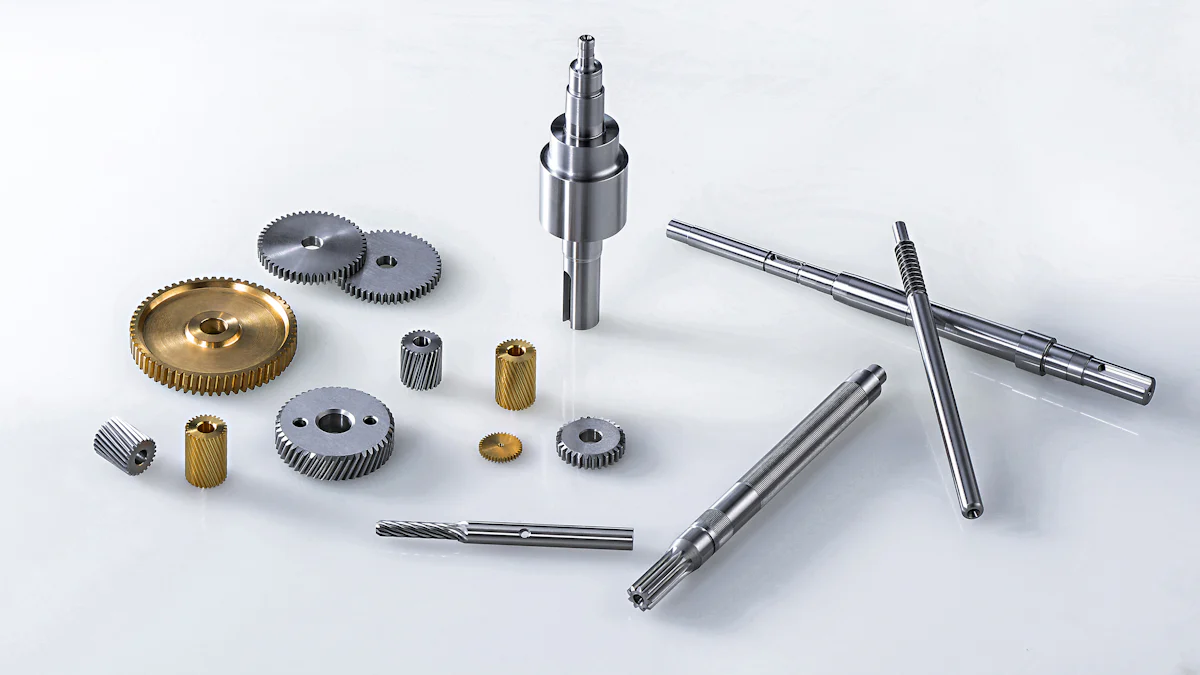 Enhancing engine performance is crucial, and the valve seat cutting tool plays a pivotal role in achieving optimal results. This blog will delve into the significance of these tools and provide a comprehensive overview of their functionality. By understanding the intricacies of valve seat cutting tools, you can make informed decisions to boost your engine’s efficiency and longevity.
Enhancing engine performance is crucial, and the valve seat cutting tool plays a pivotal role in achieving optimal results. This blog will delve into the significance of these tools and provide a comprehensive overview of their functionality. By understanding the intricacies of valve seat cutting tools, you can make informed decisions to boost your engine’s efficiency and longevity.
Overview of Valve Seat Cutting Tools
Valve seat cutting tools are essential instruments in engine maintenance and performance optimization. Understanding the valve seat cutting tool is crucial for achieving precise results in engine functionality. Precision plays a vital role in ensuring the proper alignment and sealing of the valve seats, which directly impacts engine efficiency.
Definition and Purpose
A valve seat cutting tool is a specialized device used to create or restore the valve seat in an engine cylinder head. This tool is designed to cut precise angles on the valve seat, allowing for optimal contact between the valve and the seat. Precision is paramount when using valve seat cutting tools as even minor inaccuracies can lead to decreased engine performance.
What is a valve seat cutting tool
The primary function of a valve seat cutting tool is to create a smooth and accurate surface on the valve seat to ensure proper sealing with the valve. By maintaining a clean and precise cut, this tool enhances airflow within the engine, leading to improved combustion efficiency.
Why precision matters
Precision is critical in valve seat cutting tools as it directly affects engine performance. A precisely cut valve seat ensures that there are no gaps or leaks between the valve and its seat, allowing for efficient heat transfer and combustion within the engine.
Common Features
Valve seat cutting tools commonly feature adjustable carbide blades that enable users to achieve different angles and depths during machining. Additionally, these tools are equipped for multi-angle machining, allowing for versatile customization based on specific engine requirements.
Adjustable carbide blades
The inclusion of adjustable carbide blades in valve seat cutting tools enables users to achieve precise cuts at various angles without compromising on durability or sharpness.
Multi-angle machining
With multi-angle machining capabilities, valve seat cutting tools offer flexibility in creating complex geometries on valve seats, catering to diverse engine configurations efficiently.
Methods of Valve Seat Cutting
Two primary methods are employed when using valve seat cutting tools: grinding method and cutting method. Each technique has its advantages depending on factors such as material hardness and desired precision levels.
Grinding method
The grinding method involves removing material from the valve seats using abrasive wheels. This process allows for fine adjustments and smooth finishes on the seats, ideal for achieving high levels of precision.
Cutting method
In contrast, the cutting method involves physically shaving off layers of material from the valve seats using sharp blades. This technique provides quick results while maintaining accuracy in creating well-defined seating surfaces.
Types of Valve Seat Cutting Tools
When it comes to valve seat cutting tools, there are various options available to cater to different engine requirements. Understanding the distinct characteristics of each type is essential for selecting the most suitable tool for your specific needs.
Small Diameter Tools
Small diameter valve seat cutting tools are designed for precision work in tight spaces within the engine. These tools are ideal for intricate machining tasks that require a delicate touch.
- Precise Machining: Small diameter tools excel at achieving intricate cuts with high accuracy, ensuring optimal valve seating.
- Versatile Applications: They are commonly used in engines with compact designs where larger tools cannot reach effectively.
- Enhanced Efficiency: The small size allows for detailed work on valve seats, promoting improved engine performance and longevity.
Applications and benefits
- Motorcycle Engines: Small diameter tools are often utilized in motorcycle engines due to their compact design and intricate valve seat requirements.
- Performance Vehicles: High-performance cars benefit from the precision offered by small diameter tools, enhancing overall engine efficiency.
- Aircraft Engines: In aircraft engines where space is limited, these tools play a crucial role in maintaining optimal valve functionality.
High-Performance Tools
High-performance valve seat cutting tools are engineered to meet the demands of advanced engine configurations that require superior machining capabilities.
- Advanced Features: These tools boast innovative features such as enhanced blade materials and cutting technologies for exceptional results.
- Increased Durability: High-performance tools are built to withstand rigorous use, ensuring longevity and consistent performance.
- Optimal Precision: They deliver precise cuts on valve seats, contributing to improved airflow and combustion efficiency within the engine.
Features and advantages
- Enhanced Blade Materials: High-performance tools utilize premium carbide blades that offer superior hardness and durability during machining processes.
- Advanced Cutting Technologies: These tools incorporate state-of-the-art machining techniques to achieve complex angles and geometries on valve seats efficiently.
- Consistent Performance: With high-quality construction, these tools provide reliable results across various engine types and configurations.
Replaceable Blade Tools
Replaceable blade valve seat cutting tools offer a cost-effective solution for long-term maintenance and versatility in machining operations.
- Economical Maintenance: The ability to replace blades reduces overall costs associated with tool maintenance and ensures continuous operation.
- Customizable Machining: Users can easily switch out blades to accommodate different valve seat requirements without compromising on quality.
- Extended Tool Lifespan: By replacing worn-out blades, these tools maintain their effectiveness over time, prolonging their lifespan and usability.
Cost-effectiveness and maintenance
- Budget-Friendly Option: Replaceable blade tools provide a cost-efficient solution for workshops looking to optimize their maintenance expenses without sacrificing quality.
- Easy Replacement Process: Swapping out blades is a straightforward procedure that minimizes downtime while maximizing productivity in machining tasks.
- Long-Term Investment: Investing in replaceable blade tools ensures prolonged tool lifespan, making them a valuable asset for consistent engine maintenance.
Selecting the Right Valve Seat Cutting Tool
When choosing the ideal valve seat cutting tool, several critical factors come into play to ensure optimal performance and longevity of your engine.
Factors to Consider
To begin with, the engine type is a crucial consideration when selecting a valve seat cutting tool. Different engines have varying requirements in terms of valve seat angles and dimensions, necessitating the use of specific tools tailored to each engine’s specifications. Understanding your engine type is essential for achieving precise and efficient machining results.
Another vital factor to evaluate is the material hardness of the valve seats. The hardness of the material directly impacts the cutting process, as softer materials may require different blade configurations compared to harder materials. By considering the material hardness beforehand, you can select a valve seat cutting tool that is best suited for achieving accurate cuts without compromising on quality.
Brand and Quality
When it comes to valve seat cutting tools, opting for reputable brands is paramount. Established brands often prioritize quality control and precision in their manufacturing processes, ensuring that their tools meet industry standards and deliver consistent results. Choosing a trusted brand guarantees reliability and durability in your machining operations, ultimately contributing to enhanced engine performance.
Cost vs. Performance
Balancing cost considerations with performance expectations is a crucial aspect of selecting a valve seat cutting tool. While cost-effective options may seem appealing initially, investing in high-quality tools can yield long-term benefits in terms of efficiency and durability. By weighing the upfront costs against the expected performance outcomes, you can make an informed decision that aligns with your budget constraints while maximizing machining effectiveness.
Recapping the essential points discussed in this comprehensive guide, mastering valve seat cutting tools is crucial for optimizing engine performance. Choosing the right tool based on engine type and material hardness is paramount to achieving precise cuts and ensuring efficient combustion. Looking ahead, future trends indicate a shift towards advanced machining technologies like replaceable blade tools for cost-effective maintenance. In conclusion, selecting high-quality valve seat cutting tools from reputable brands is key to enhancing engine longevity and performance.
By considering these factors and staying informed about emerging trends, individuals can elevate their engine maintenance practices and drive towards greater efficiency in machining operations.
